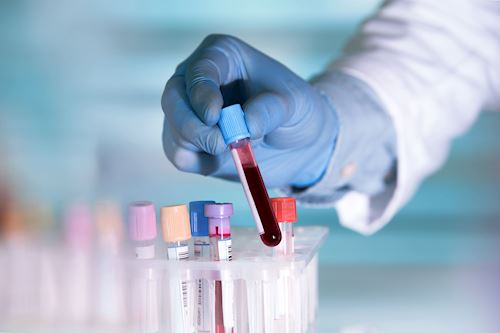 1. Hemophilia is a sex-linked recessive disorder affecting males. Severe hemophiliacs produce less than 1% of clotting Factor VIII (Hemophilia A) or Factor IX (Hemophilia B). The absence of either of these clotting factors causes a defect in the intrinsic clotting mechanism and the patient is unable to produce normal fibrin clots to stop bleeding.
1. Hemophilia is a sex-linked recessive disorder affecting males. Severe hemophiliacs produce less than 1% of clotting Factor VIII (Hemophilia A) or Factor IX (Hemophilia B). The absence of either of these clotting factors causes a defect in the intrinsic clotting mechanism and the patient is unable to produce normal fibrin clots to stop bleeding.
2. The symptoms of Hemophilia include excessive bleeding. This bleeding may occur externally due to injury but more often occurs spontaneously as bleeding into the joints. Symptoms are often first evident during circumcision. In this case, the infant had not been circumcised. Symptoms did not become evident until the infant became mobile. These symptoms manifested themselves as bleeding from the mouth due to injury and bruising due to internal bleeding. Spontaneous bleeding into the joints can lead to joint deformities and arthritis.
3. The diagnosis of Hemophilia was made based on the patient's symptoms, family history, and bleeding tests. Diagnostic tests included a platelet count, bleeding time, PT, and APTT. A prolonged APTT led to Factor Assay testing which showed less than 1% of factor VIII present in the blood.
4. Treatment of Hemophilia consists of replacing the deficient factor. The factor can be replaced routinely to control spontaneous bleeding but often is used only when the patient has started to bleed spontaneously or is undergoing dental work or surgery. Limited factor replacement is done to avoid the expense and also to avoid unnecessary exposure to blood-borne viruses. Directed donor cryoprecipitate is the least expensive method of treatment. Patients use a donor they know is "safe" who donates plasma as needed. Cryoprecipitate, rich in factor VIII, is made from the donor plasma. Varying levels of purified cryoprecipitate are also available to the patient. Recombinant Factor Replacement is genetically engineered factor VIII. This is free of contaminating viruses but the most expensive treatment alternative.
5. The prognosis for hemophiliacs is much better than in the past. New treatment methods are relatively safe from AIDS and Hepatitis viruses. With frequent injections of factor replacements, joint deformities and arthritis can be alleviated. Scientists are currently experimenting with using genetic engineering as a "cure." Genes that produce the missing factor are inserted by viral vectors into the patient's cells. These cells now begin to produce the missing factor. This method is currently being tested in humans.
6. The only method of prevention for Hemophilia is to not pass the x-linked gene. This poses a very difficult and personal dilemma for women who are carriers of the gene or for hemophiliac males; the question of having children who are at risk or do not have children.
7. Although the healthcare workers listed in this case are minimal, many healthcare workers will be involved throughout Steven's life. In this case, the pediatrician made the diagnosis. He referred Steven to a hematologist, a doctor specializing in disorders of the blood. A medical laboratory technologist performed the coagulation studies on the blood which provided the data for diagnosis. A genetic counselor was involved to map out a pedigree chart and counsel with family members who are carriers of the gene. As Steven matures and encounters spontaneous bleeding into the joints, he will most likely need the services of a radiologist and radiologic technician for imaging studies as well as a physical therapist to help rehabilitate the joints after a bleed. Nurses, in this case, would be responsible for injecting cryoprecipitate, and educating the family so that injections can be given at home.
